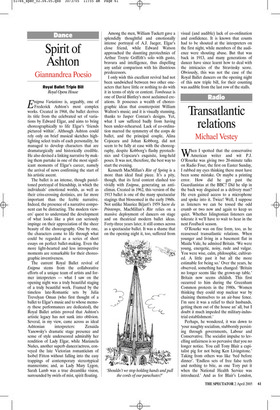Spirit of Ashton
Giannandrea Poesio
Royal Ballet Triple Bill
Royal Opera House
Enigma Variations is, arguably, one of Frederick Ashton’s most complex works. Created in 1968, the ballet derives its title from the celebrated set of variations by Edward Elgar, and aims to bring choreographically to life Elgar’s ‘friends pictured within’. Although Ashton could rely only on brief musical sketches highlighting select traits of each personality, he managed to develop characters that are dramaturgically and historically credible. He also devised a linking narrative by making them partake in one of the most significant moments of Elgar’s career, namely the arrival of news confirming the start of his artistic ascent.
The ballet is an intense, though pasteltoned portrayal of friendship, in which the individuals’ emotional worlds, as well as their criss-crossing destinies, are far more important than the feeble narrative. Indeed, the presence of a narrative component can be distracting. The modern viewers’ quest to understand the development of what looks like a plot can seriously impinge on their appreciation of the sheer beauty of the choreography. One by one, the characters come to life through what could be regarded as a series of short essays on perfect ballet-making. Even the more light-hearted and less introspective moments are remarkable for their choreographic inventiveness.
The current Royal Ballet revival of Enigma stems from the collaborative efforts of a unique team of artists and former interpreters — what I saw on the opening night was a truly beautiful staging of a truly beautiful work. Framed by the timeless late-Romantic sets by Julia Trevelyan Oman (who first thought of a ballet to Elgar’s music and to whose memory these performances are dedicated), the Royal Ballet artists proved that Ashton’s artistic legacy has not sunk into oblivion. Several, in my view, came across as ideal Ashtonian interpreters: Zenaida Yanowsky’s dramatic stage presence and sense of style underscored admirably her rendition of Lady Elgar, while Marianela Nuñes, another superb dancer/actress, conveyed the late Victorian romanticism of Isobel Fitton without falling into the easy trappings of contemporary stereotypical mannerisms; and, as Lady Mary Lygon, Sarah Lamb was a true dreamlike vision, surrounded by swirls of mist, spirit floating. Among the men, William Tuckett gave a splendidly thoughtful and emotionally intense portrayal of A.J. Jaeger, Elgar’s close friend, while Edward Watson approached the daunting pyrotechnics of Arthur Troyte Griffith’s solo with gusto, bravura and intelligence, thus dispelling any unfair comparison with his illustrious predecessors.
I only wish this excellent revival had not been sandwiched between two other oneacters that have little or nothing to do with it in terms of style or content. Tombeaux is one of David Bintley’s most acclaimed creations. It possesses a wealth of choreographic ideas that counterpoint William Walton’s music; and it is visually stunning, thanks to Jasper Conran’s designs. Yet, what I saw suffered badly from having been under-rehearsed. Lack of co-ordination marred the symmetry of the corps de ballet, and the principal couple, Alina Cojocaru and Johan Kobborg, did not seem to be fully at ease with the choreography, despite Kobborg’s flashy pyrotechnics and Cojocaru’s exquisite, long-held poses. It was not, therefore, the best way to start the evening.
Kenneth MacMillan’s Rite of Spring is a more than ideal final piece. It’s a pity, though, that its feral content clashed too vividly with Enigma, generating an anticlimax. Created in 1962, this version of the 1913 ballet is one of the many spectacular stagings that blossomed in the early 1960s. Not unlike Maurice Béjart’s 1959 Sacre du Printemps, MacMillan’s Rite relies on a massive deployment of dancers on stage and on theatrical modern ballet ideas. Forty-three years later, it still comes across as a spectacular ballet. It was a shame that on the opening night it, too, suffered from visual (and audible) lack of co-ordination and confidence. It is known that counts had to be shouted at the interpreters on the first night, while members of the audience were shouting abuse. But that was back in 1913, and many generations of dancer have since learnt how to deal with the intricacies of the Stravinsky score. Obviously, this was not the case of the Royal Ballet dancers on the opening night of this new triple bill, for their counting was audible from the last row of the stalls.





























































 Previous page
Previous page